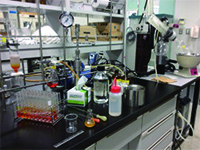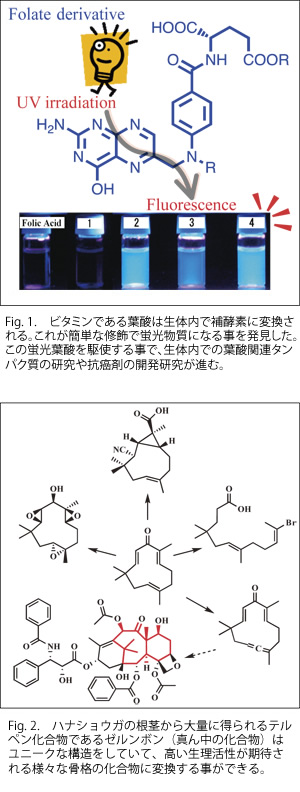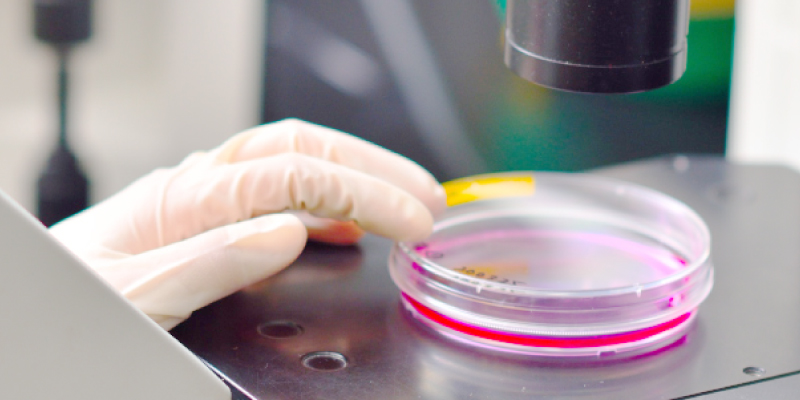
河合 靖
(かわい・やすし)
Yasushi Kawai
略歴
- 京都大学大学院理学研究科博士後期課程退学
- 京都大学化学研究所教務職員、同助手を経て本学へ
生物有機化学研究室

卒業研究テーマ例
- ビタミン由来の新規蛍光プローブの開発とその生理機能解明への応用
- 生体高分子の構造変化を検出する新規蛍光プローブの開発
- 植物由来テルペン化合物の誘導体化とその生理活性に関する研究
酵素活性検出蛍光プローブの開発
新規蛍光性生体関連物質の開発
酵素を利用した新規生理活性物質の合成

バイオサイエンスの研究において酵素は最も重要な分子の一つである。この酵素に関して基礎と応用の両面から研究を進めている。
例えば、水溶性ビタミンは補酵素の前駆体である場合が多いが、これらを化学的に修飾し機能化する事で、酵素研究の新しいツールとしての可能性が広がる。こういったケミカルバイオロジー的手法による生体機能の解明を行っている。
具体的には、ビタミンである葉酸は蛍光を発しないが、誘導体化する事で蛍光を発する物質になる事を見いだした。この変化をうまく利用し、分子設計する事で新しい酵素活性検出蛍光プローブを幾つか開発してきた(Fig. 3)。
また、豊富な天然資源から新しい生理活性物質の探索も行っている。それには微生物が有している様々な酵素が利用できる。植物から大量に得られるテルペン化合物であるゼルンボンを、微生物により様々な化合物に変換しそれらの生理活性を評価し、より活性の高い化合物を探索している。

- 研究の応用領域
- 医薬品・機能性食品の開発
新規蛍光プローブの開発 - 産官学連携で求めるパートナー
- 医薬品・機能性食品の開発の研究者
化学企業、製薬企業、食品企業、研究機関
Research activities are concerned with bioorganic chemistry, chemical biology, and enzymatic chemistry, in order to develop novel functional and biologically active compounds such as antitumor agents, antibiotics, and fluorescent probes. The major projects are: synthesis of biologically active compounds with the use of enzymes or microbes; development of novel fluorescent probes for protein imaging; development of functionalized analogues of coenzyme.
Current research topics are as follows:
Functionalization of water-soluble vitamins
It is well known that folic acid acts as a coenzyme in numerous metabolic reactions and its receptor is overexpressed in tumor cells. We found that a simple derivatization of folic acid to give fluorescent compounds. They have been developed as useful probes for the detection of folate-related proteins and drug delivery systems for anticancer agents. Fluorescent properties of these compounds have also been studied. We have developed a new rational design of fluorescent probes using pterin derivatives.
Enzymatic transformation of terpenes
Zerumbone is a monocyclic sesquiterpene found as the main component of the essential oil of a wild ginger, Zingiber zerumbet Smith. It has been found to have biological activities such as anti-inflammatory, antitumor, and antibacterial activity. Therefore, it would be expected that its derivatives exhibit a variety of biological activities. Enzymatic or microbial transformation of zerumbone and its derivatives is a very attractive method to obtain chiral compounds. Various compounds have been synthesized with this method and their biological activity has been studied.
Y. Utaka, G. Kashiwazaki, N. Tsuchida, M. Fukushima, I. Takahashi, Y. Kawai, and T. Kitayama, Remarkable Potential of Zerumbone to Generate a Library with Six Natural Product-like Skeletons by Natural Material-Related Diversity-Oriented Synthesis, Journal of Organic Chemistry, 85, 8371-8386 (2020).
M. Kurogi, Y. Kawai, K. Nagatomo, M. Tateyama, Y. Kubo, and O. Saitoh, Auto-oxidation products of epigallocatechin gallate activate TRPA1 and TRPV1 in sensory neurons, Chemical Senses, 40, 27-46 (2015).
T. Kitayama, M. Nakahira, K. Yamazaki, H. Inoue, C. Imada, Y. Yonekura, M. Awata, H. Takaya, Y. Kawai, K. Ohnishi, and A. Murakami, Novel synthesis of zerumbone-pendant derivatives and their biological activity, Tetrahedron, 69, 10152-10160 (2013).
Y. Hirose, E. Ohta, Y. Kawai, and S. Ohta, Dorsamin-A’s, Glycerolipids Carrying a Dehydrophenylalanine Ester Moiety from the Seed-Eating Larvae of the Bruchid Beetle Bruchidius dorsalis, Journal of Natural Products, 76, 554-558 (2013).
T. Kitayama, S. Ohta, Y. Kawai, T. Nakayama, and M. Awata, Synthesis of optically active tetrahydrozerumbone. Tetrahedron: Asymmetry, 21, 11-15 (2010).






